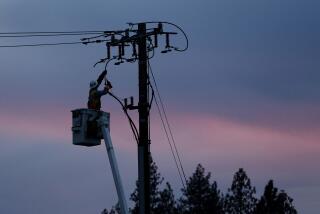AT&T; Proposes Record Rate Cut : Asks FCC for $1.5-Billion Long-Distance Fee Trim
- Share via
American Telephone & Telegraph proposed the largest rate cut in the company’s history Thursday, asking federal regulators for permission to slash long-distance charges by $1.5 billion, effective June 1.
If the cut is approved by the Federal Communications Commission, the cost of a 10-minute, business-hours AT&T; call between Los Angeles and New York would drop to $3.91 from $4.43. A similar call between Los Angeles and Houston would cost $3.56 instead of $4.07.
The reductions would take effect the same day local telephone companies will raise to $2 the $1 monthly long-distance “access” charge to customers with one phone line, and the monthly fee AT&T; pays for its connection into the local phone system will drop.
The FCC, in a 1984 ruling, ordered AT&T; to pass along the resulting savings to its customers, dollar for dollar.
Overall, the decrease would drop AT&T;’s rates 19.1% below where they stood on Jan. 1, 1984--the day the old Bell System was dissolved to settle a long-standing antitrust lawsuit. The company reduced its tolls 6.4% in 1984 and 5.6% in 1985.
The breakup was expected to increase local phone charges but result in much larger decreases in toll calling because of increased competition.
The biggest cuts would come in rates for daytime and evening calling Mondays through Fridays--11.4%--while rates for late-night, weekend and holiday calling would be trimmed just 2.7%.
The AT&T; proposal would focus the decrease in the time slots where competition is keenest. Indeed, spokesmen for AT&T;’s major competitors--MCI and GTE Sprint--indicated that their companies will likely match whatever AT&T; cuts the FCC allows.
Robert B. Morris III, who follows the telecommunications industry for Montgomery Securities in San Francisco, said these price reductions, if they materialize, will not hurt the carriers’ profit margins. Most of the rate adjustment, Morris explained, stems from the sharply reduced charges the carriers will pay local phone companies, under previous FCC orders, for originating and completing interstate calls.
The FCC’s goal in shifting more of the access charges from carrier to customer is to replace the internal subsidies by which the Bell System traditionally kept local rates below cost to make basic telephone service universally affordable as required by federal law.
Charge Called Unfair
Revenue from long-distance rates and Yellow Pages advertising provided much of that subsidy in the days when AT&T; offered both local and long-distance calling as a fully regulated monopoly utility.
Some studies have estimated that long-distance rates were as much as 60% overpriced under the Bell System.
Sen. Albert Gore Jr. (D-Tenn.) proposed legislation on Wednesday to throw out the FCC-imposed charges on residential customers, a move Congress has toyed with before. Gore called the charge unfair to customers who make few or no long-distance calls.
The fact that AT&T; intends to make its greatest cuts in daytime and evening calling Mondays through Fridays drew criticism from the Consumer Federation of America, which claimed that this favors business callers over residential customers.
“This is a pretty skewed rate reduction,” said Gene Kimmelman, the federation’s legislative director in Washington. “The big winner here is the business people who use long distance during the day.”
An AT&T; spokesman called that claim “flat-out wrong.”
“We find that about 45% of our revenues from the residential customer comes during the evening period, and the remainder is split just about evenly between day and night calling,” said Larry Garfinkel, AT&T; vice president for marketing. “Our motivation was to pass cost savings through (to customers) and help improve the return on service.”
Under AT&T;’s proposal, the cost of Wide Area Telephone Service--private lines leased by high-volume business customers--also would drop 12.8% during weekday and evening hours and 5% from 11 p.m. until 8 a.m. and on weekends and holidays.
Rates for toll-free “800 service” would drop by 9.8% days and evenings and 2% at night and on weekends.
More to Read
Inside the business of entertainment
The Wide Shot brings you news, analysis and insights on everything from streaming wars to production — and what it all means for the future.
You may occasionally receive promotional content from the Los Angeles Times.









